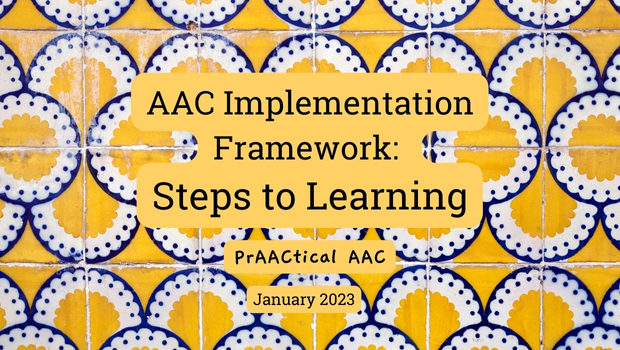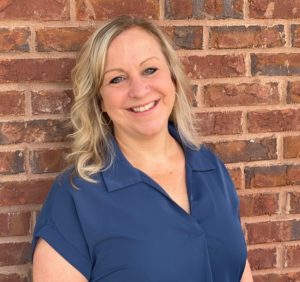AAC Implementation Framework: Steps to Learning

 We’re so pleased to welcome PrAACtical AAC contributor Vicki Clarke back to these pages. While you may remember Vicki from her outstanding AAC Assessment Corner posts, her most recent efforts focus on strengthening our AAC practices. Throughout the series, Vicki draws on her experiences supporting AAC users and teams in clinical and school settings and shares prAACtical information that we can all learn from
We’re so pleased to welcome PrAACtical AAC contributor Vicki Clarke back to these pages. While you may remember Vicki from her outstanding AAC Assessment Corner posts, her most recent efforts focus on strengthening our AAC practices. Throughout the series, Vicki draws on her experiences supporting AAC users and teams in clinical and school settings and shares prAACtical information that we can all learn from
Introduction to AAC 101 Steps to Learning
It is no small task to consider how we will help our students progress from communicating only through behaviors to communicating any message they desire independently and spontaneously. In fact, in 1997, Gloria Soto conducted survey research that tells us:
- Teachers have always believed that communication training for students is positive, and
- Communication training is a collaborative effort between teachers and SLPs,
Despite these beliefs, there is still a prevalent hesitancy to begin to explicitly instruct students in AAC.
We need a shared understanding of the term “communication.” Communication is not simply responding or labeling. Communication is a way to meet your needs, a means to socially connect, share unknown information with a partner, and it involves a message you choose YOURSELF.
Musselwhite and Howard, in their 2021 ASHA session, “Effective, Engaging AAC Instruction,” talked about the need for us to teach communication through both explicit and embedded instruction. Explicit instruction is a targeted, planned activity that targets a specific word or message. It often occurs in a therapy room or within a structured activity. Embedded instruction occurs during naturally occurring activities when the situation demands it, or simply provides an opportunity for it. The key to embedded instruction is that it occurs within authentic activities, not ones we’ve engineered for instruction. It is important when we teach communication that we have both components in our instruction, but that’s not always what happens. Many times, communication instruction occurs only in structured explicit tasks that occur in a pull-out speech therapy session or when the speech therapist is in the classroom.
Dr. Soto found that teachers’ willingness to use AAC in the classroom is dependent on their perception of their students’ ability to learn to communicate effectively. This is not as simplistic as saying teachers don’t believe in their students. This perception is HIGHLY DEPENDENT ON the teachers’ perceptions of their OWN skills and responsibilities, and their ability to teach their students to use AAC effectively!
This perception makes sense. There is no step-by-step manual for how to teach AAC, no scope and sequence of the whole process. Teachers and therapists are asked to try a myriad of techniques and materials without always knowing exactly what the outcomes are going to be. There’s no clear ending point and no sequence to follow. This gets us back to our original issue- teachers aren’t sure the students will be able to learn to communicate effectively, BECAUSE they aren’t sure if they know how to teach communication and even IF IT’S THEIR JOB TO DO SO.
Teaching students to communicate using AAC and speech requires the expertise of BOTH the teacher and the SLPs, and if we are being honest, participation from the family too! Once we have everyone on board, it’s just a matter of identifying the steps and supplying the training tools to the team.
So this is where the AAC 101 Steps to Learning framework comes into play. The Steps to Learning framework is our attempt to give our teachers, therapists, and families a specific sequence of activities, with supporting materials, in order to empower the team in moving their student from communicating through behaviors and facial expression to communicating autonomously, being able to say what they want to say when they want to say it to whoever they want to say it to!
There are five steps to this sequence: target, train, take in, try it, and talk.
In Step One – Target, we select the words and messages we are going to teach.
In Step Two – Train, we begin the process of training HOW we say the word or message. We are learning where the symbol lives on our AAC system, what it looks or sounds like, the motor sequence to navigate through pages on our AAC applications, and of course signing or saying the word, if that’s appropriate.
Step Three – Take In, is all about the partner, modeling how the word/message is used in the real world. The point of this step is for the student to begin to understand when to use these words and messages, and what it looks like when someone communicates using the method that they will ultimately be using themselves. This is exactly how infants and toddlers begin to learn to speak, by watching and experiencing their parents and the other adults around them communicating by talking to each other for real purposes.
In Step Four – Try It, we are finally asking the student to begin to try saying the word or messages for real purposes with help and prompting as needed, of course. We are considering partner strategies for encouraging students to communicate self-generated messages.
Finally, Step Five – Talk, is our ultimate goal, that our student will begin to communicate with speech or AAC, saying the word or message independently for their own real purposes, to be able to say what they want to say when they want to say it to whomever they want to say it to!
During the next 5 posts, we will dig into each step, and share the tools we recommend daily in our DTA Schools classrooms!
You can see a video version of this post below.
Direct Link to Video – https://www.youtube.com/watch?v=M7wPZcJ7j7Q&ab_channel=VickiClarke%26AACChicksatDTASchools
References
Gloria Soto (1997) Special education teacher attitudes toward AAC: preliminary survey, Augmentative and Alternative Communication, 13:3, 186-197, DOI: 10.1080/07434619712331278008
Caroline R. Musselwhite, EdD, CCC-SLP, and Krista Howard, AA (2021) Effective, Engaging AAC Instruction presented at the online conference, Expanding AAC: Accessible Strategies for Functional Communication, December 1-13, 2021.
About the Guest Author
Vicki Clarke is the CEO of Dynamic Therapy Associates, Inc and Director of DTA Schools, a division of DTA Inc, supporting both individual student growth and, system-wide focus on the development of augmentative communication skills, supports, and best practices in special education programs. Additional professional activities include professional consultation and training through publications, workshops, and presentations at local, state, and national conferences in the areas of AAC, speech-language pathology, special education, and Autism.
Filed under: Featured Posts, PrAACtical Thinking
This post was written by Carole Zangari
